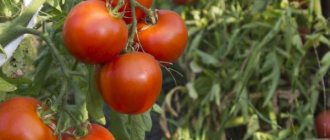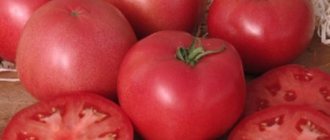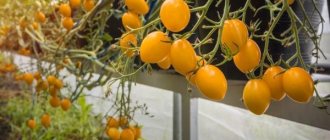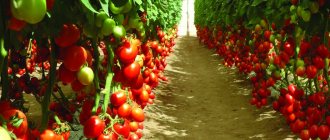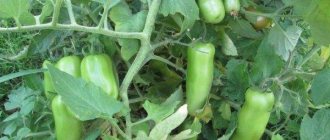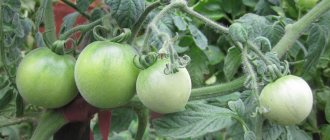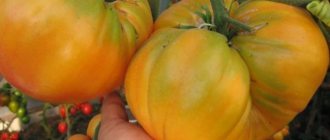Description of the Kolobok tomato variety, its characteristics and yield
Every year the variety of tomato varieties and hybrids is replenished with new and interesting specimens, but some varieties firmly withstand the competition and continue to delight gardeners with rich harvests. One of these varieties is tomat Kolobok. It has been grown since the 90s, and it got its name for the ideal roundness of the fruit.
Features of the variety
Kolobok is an early ripening variety of determinate type. It is distinguished by uniform ripening of fruits. The period from germination to fruiting, on average, is 90–105 days.
- bush height 45–55 cm;
- leaves are medium sized, green;
- inflorescences are simple, the first raceme is formed above the 6th–7th leaf;
- the stalk has no articulation;
- yield - from 1.5 to 4 kg per 1 sq. m.
- round, smooth shape;
- fruit weight from 50 to 70 grams;
- the skin is strong and smooth;
- The color of ripe tomatoes is bright red;
- inside the fruit is divided into at least 4 segments, the seeds are small;
- the pulp is dense and juicy, with a rich tomato taste;
- The fruits are stored for a long time and are not prone to mechanical damage during transportation.
Thanks to their excellent taste and beautiful appearance, Kolobok tomatoes are universal in use and suitable for sale.
Growing and care
Tomato variety Kolobok is recommended to be grown in open ground in the Central region of the Russian Federation:
- It is recommended to sow seeds for seedlings at the end of March.
- The seed sowing depth is 1–1.5 cm.
- In the phase of appearance of the first true leaves, plants are picked.
- After picking and before planting seedlings in the ground, 2-3 fertilizing with mineral fertilizers should be done.
- 7–10 days before transplantation, the sprouts must undergo a hardening course. To do this, you need to place the seedlings on the balcony or open the window, avoiding drafts.
- Moving to permanent residence is carried out from April to May, depending on climatic conditions.
- Planting pattern - 50x60 cm.
- The bushes do not require shaping, but as they grow and produce fruit, they may need to be tied to a support.
- Kolobok, like all tomatoes, needs timely watering and periodic hilling. It is advisable to water moderately and at the root. Since excess moisture can lead to late blight and other fungal diseases.
- To avoid collisions with insect pests, it is recommended to carry out preventive spraying of plants.
Reviews from those who have already planted the Kolobok variety are mostly positive and speak about the unpretentiousness of the tomato, and also highlight its excellent taste and attractiveness of the fruit.
Reviews
Olga Chumakova, Perm:
“I’ve been planting gingerbread for many years. Tomatoes have a great taste and are ideal for pickling. And compared to other varietal tomatoes, this variety practically does not get sick and does not require special attention.”
Valery Ulanov, Moscow:
“I planted Kolobok in open ground, without seedlings, under covering material. The seedlings sprouted together and did not experience any difficulties in development.”
Svetlana Krotova, Smolensk:
“I planted Kolobok for the first time last year. The whole family was pleased, the children ate it right out of the bush and put it in jars for the winter. We will plant more."
Caring for adult tomatoes
Tomato Klusha is undemanding in care. For full development, it only needs timely, abundant watering and loosening of the soil.
Tying up
The variety is distinguished by a strong stem that can easily withstand strong wind or rain. In the early stages of cultivation, staking is not required. However, in favorable years, a large number of tomatoes are formed on the plant. During the ripening process, their weight reaches 2.5 kg. During this period, tying will prevent damage to plants under the weight of the crop.
Stepsoning
For good ventilation and to prevent fungal diseases, all lower stepsons and leaves of the variety are cut off. The plant no longer needs any pruning or shaping.
Watering and fertilizers
In the absence of rain, the tomato is watered abundantly. The best time for this is evening. Thanks to late watering, the plants have time to get enough moisture during the cool night.
Weeding and loosening
For the full development of tomatoes, loose soil saturated with oxygen is necessary. After removing weeds, a period of rain and each watering, it is loosened using garden tools.
Description of the Kolobok tomato, growing rules and reviews from gardeners
The Kolobok tomato got its name because of its perfectly round shape, reminiscent of a kolobok. And the bright red color gives the fruit a special charm. Our gardeners like early-ripening tomato varieties, which include Kolobok, because it is ideal in conditions of long winters and short summers.
This is a determinate plant, the maximum height of which is 55 cm. Tomatoes ripen together, the yield is quite high. The weight of 1 fruit varies between 55-65 g. The fruits tolerate transportation well over long distances, which is important for farmers.
What is a Kolobok tomato?
Let's take a closer look at the characteristics and description of tomatoes: what they like, how to plant them correctly.
Manufacturers always indicate whether tomatoes belong to one species or another. When purchasing, you must take this feature into account, since different varieties of tomatoes grow and form differently.
So, what do you need to know about the determinate variety to which our Kolobok belongs? This is a variety of the variety that has limited growth. When an ovary with fruits forms at the top of the bush, the plant stops growing. The type of tomato can also be determined after the first shoots appear: in a determinate variety, the cotyledon length is 1-3 cm.
The first flower raceme is formed after 6-7 leaves (much later in indeterminate plants). Few leaves are formed between the brushes, about 3 pieces each. Another feature of this type is that the brushes can be tied from shoots. All this indicates the accelerated development of the plant, which is why it ripens early.
How are tomatoes grown?
As for caring for Kolobok, you need to adhere to the following rules:
- periodically carry out hilling;
- correctly step-son;
- to improve branching, pinch stems;
- feed with fertilizers in a timely manner (it is best to do this before hilling);
- water only as needed;
- carry out pest and disease control if necessary.
Many people do not grow determinate varieties of tomatoes, but this is not entirely correct. When a plant has support, it grows in one direction: the stem points upward, but the branches do not fall to the ground. Firstly, it is easier to care for such bushes, and secondly, the tomato is less susceptible to disease and insect attack.
As for morbidity, for example, late blight (a fungal disease) can occur from waterlogging of leaves and soil. Therefore, many gardeners use drip irrigation so that the water falls strictly on the root system without touching the upper part of the bush.
If you notice that the plant has become infected with a fungal disease, it will need to be treated with the following solutions: Infinito, Ridomil Gold, Aliette, Tattu. The most dangerous insects are the Colorado potato beetle, aphids, and winter cutworms. They can be exterminated using the drugs Actofit, Fitoverm or Confidor.
A few words about planting seeds. Seeds for seedlings are sown at the end of the first spring month. In order for the seed germination process to go smoothly, before the beginning of May (when the frosts have passed, it is time to plant in the ground), you need to do a few simple things.
Prepare the grains for planting by soaking them in a solution of salt water. The seeds that have sunk to the bottom of the glass will give 100% germination. To prevent diseases, you should keep the grains in a light solution of manganese (30 minutes will be enough).
Planting must be done in a pre-prepared substrate to a depth of 1-2 cm. Be sure to cover the entire area with film and put it in a warm place.
When planting in the ground, the depth of the holes should correspond to the length of the roots of the seedlings. It is necessary to plant seedlings at a distance of 50-60 cm so that overgrown bushes do not interfere with each other.
Reviews
Olga Chumakova, Perm:
“I’ve been planting gingerbread for many years. Tomatoes have a great taste and are ideal for pickling. And compared to other varietal tomatoes, this variety practically does not get sick and does not require special attention.”
Read also: How to cook Argentine shrimp without head
Valery Ulanov, Moscow:
“I planted Kolobok in open ground, without seedlings, under covering material. The seedlings sprouted together and did not experience any difficulties in development.”
Svetlana Krotova, Smolensk:
“I planted Kolobok for the first time last year. The whole family was pleased, the children ate it right out of the bush and put it in jars for the winter. We will plant more."
The Kolobok tomato got its name because of its perfectly round shape, reminiscent of a kolobok. And the bright red color gives the fruit a special charm. Our gardeners like early-ripening tomato varieties, which include Kolobok, because it is ideal in conditions of long winters and short summers.
This is a determinate plant, the maximum height of which is 55 cm. Tomatoes ripen together, the yield is quite high. The weight of 1 fruit varies between 55-65 g. The fruits tolerate transportation well over long distances, which is important for farmers.
Tomato Kolobok characteristics and description of the variety, reviews from gardeners with photos
More about tomato
The description and characteristics of tomatoes can help you study the rules for caring for them.
This variety was developed by breeders. The bush is small, it does not require tying or pinching. The foliage is moderate, the inflorescences are simple. Fruit ripening usually occurs three months after germination.
There are a lot of fruits on the bush, they hang like a toy on a Christmas tree, 6-7 pieces hang on the brush. The shape of these fruits is very unusual. Elongated, rectangular with a rounding at the base. Similar to pepper. Color ranges from orange to red. Length up to 12 centimeters, weight up to 150 grams. The pulp is dense, the taste is sweet, but acid is also present.
This tomato is good for preparing salads, as well as various preparations for the winter: pasta, adjika, pickling, salting. It will be delicious to make dried or sun-dried tomatoes from them. They look very nice in jars. They can be collected unripe and stored until they turn red. But, ripening on the branch, the taste will seem brighter.
During ripening, simultaneous harvesting occurs. This variety is good for sale and is normal for transportation, since their skin is dense and thick. Doesn't crack.
Characteristics of the variety
According to the information contained in the description and characteristics, this variety is indeterminate. This suggests that such tomatoes can reach very large sizes. If you plant tomatoes in open ground, the bushes will be about 0.5 m in height. In greenhouse conditions, this variety stretches more than 2 m.
This plant has a well-developed root system. If tomatoes grow in open ground, in an area where there is frequent wind, tying the plant to a strong support will be mandatory.
Caring for the Dear Guest variety tomato is as simple as possible. They do not need to be pinched, shaped or pinched. These tomatoes require moderate watering, and the most common mineral fertilizing is required, which is applied before the fruit begins to ripen. With proper care, you can get a good harvest from each bush.
Dear Guest tomatoes are early ripening, so they have time to ripen even during the short summer season. They attract the attention of summer residents due to their ease of care and low incidence of disease. Breeders have created a variety that is resistant to most diseases that affect tomatoes. Moreover, the fruits ripen quickly enough, so many diseases simply do not have time to develop and affect the crop.
It is recommended to plant Dear Guest exclusively using seedlings. To do this, you need to sow the seeds in the ground in March, mulch them and put them in a warm place for germination. Water the seedlings with warm water through a strainer. The germination rate of seeds of this variety is very high.
Strong seedlings should be planted in a permanent place (60 days after sowing). You should not plant bushes too close, as this may negatively affect the yield. With proper care, you can harvest 4-5 kg of tomatoes from each bush.
The characteristics and description of the variety are as follows:
- The first harvest of Cornet tomato is obtained 85-90 days after seed germination.
- The height of the tomato bush is 0.45-0.5 m. An average number of green leaves develops on the stem.
- Each cluster produces 4 to 5 fruits.
- In an agricultural catalogue, the description of a plant's fruit begins with its shape. Tomatoes look like a ball with a smooth side surface. Ripe fruits are painted in bright shades of red.
- The weight of the fruit ranges from 0.1 to 0.11 kg. The skin and pulp of the Cornet tomato have increased density. There are 4-5 seed chambers inside the fruit.
Reviews from farmers who planted the described variety show that its yield is 3.8-4.2 kg of fruits per 1 m² of bed. Most gardeners grew Cornet in open ground, so the indicated yield figures can be significantly improved if the crop is grown in a greenhouse.
Vegetable growers note the friendly ripening of the plant’s fruits. Due to the early ripening period, Cornet is not susceptible to late blight. As almost all farmers note, the tomato variety described is unpretentious to growing conditions. The bush takes up little space, which allows for maximum compaction of plantings. The density of planting bushes in the beds has virtually no effect on the formation and development of ovaries.
Trading companies willingly buy Cornet from the population, since its fruits can be transported over any distance.
Features of cultivation
“Full-full” is an indeterminate variety of standard type. It begins to bear fruit 115-120 days after germination.
- The bushes are powerful, height from 1 to 1.5 meters.
- Weak root system.
- The plant is medium-branched, heavily leafy, with short internodes.
- The inflorescences are simple, with 5-7 fruits.
- The first brush is laid after 6-7 sheets, the subsequent ones - every two.
- The yield is high, yielding 11-13 kg of tomatoes per 1 sq. m.
The variety is recommended for growing in greenhouses and greenhouses, but in central Russia, where the climate is milder, it can also be planted in open ground.
- The shape is round and smooth.
- Weight 100-200 grams.
- The color of ripe fruits is bright red.
- The skin is dense and smooth.
- Rich taste and aroma.
- Well kept.
Thanks to the excellent taste and size of the fruit, Polompolno tomatoes are suitable for universal use: they are equally good for fresh consumption and for canning.
These tomatoes are grown in seedlings from germinated seeds. They begin to be planted in March. After sowing, you need to cover with film and monitor the temperature, it should not be lower than 18 degrees. Before planting, you can soak the seeds in a special solution, which will protect future plantings from diseases and help them germinate faster.
Description of fruits
Tomatoes of the Dear Guest variety can be classified as salad tomatoes. They are large, round and flat. The color of a ripe tomato should be bright red. Closer to the ground, large fruits weighing about 500 g appear. At the top there will be smaller tomatoes, the weight of which does not exceed the 200 g mark.
Winter preparations from such tomatoes do not turn out very well - in general, tomatoes are poorly preserved due to their softness. But for juice or sauce, the Dear Guest tomato is perfect.
Growing and care
According to the description of the variety, it is clear that the “Full-full” tomato is unpretentious and does not require special care; it is enough to provide the plant with regular watering and periodically loosen the soil.
- Seeds for seedlings should be sown 60-65 days before the intended transplantation to a permanent habitat.
- After the first 1-2 leaves appear, the shoots must be pruned. In the southern regions, you can sow directly into the ground under covering material, in case of frost.
- Sprouts need additional nutrition, so they should be fed.
- 10-14 days before planting in the ground, tomatoes need to begin to harden so that the adaptation process is less painful.
- It is recommended to place 3-4 bushes per 1 square meter. m.
- During the growth process, you need to remove the stepsons, forming a bush of 1-2 stems. The bush, although powerful, due to its underdeveloped root system, needs to be tied to a support.
- It is recommended to mulch the soil around the bush with hay or sawdust. This will protect the tomatoes from lack of moisture and make it easier to fight weeds.
How to grow tomatoes
The crop is grown through seedlings. Sowing work begins in the second ten days of March, 60–65 days before transferring to closed ground.
Seeds do not need to be treated with potassium permanganate or soaked in growth stimulants before sowing. This is what they do in production.
To identify empty grains, a calibration method is used. The seeds are soaked for 10 minutes in a saline solution (1 tsp per glass of water at room temperature). Poor quality material will float to the surface; it is not used for sowing. The seeds remaining at the bottom of the glass are washed with warm running water.
Soil for growing seedlings is prepared from equal parts of turf, peat and river sand with the addition of superphosphate (40 g per bucket of soil mixture). They also use ready-made substrate in bags for growing seedlings of peppers and tomatoes. Such soil is already enriched with nutrients.
Before use, the soil is disinfected in an oven, steamer, and treated with a solution of potassium permanganate or “Fitosporin M”. The procedure prevents the development of bacteria and fungi in the soil.
After the shoots appear, the film is removed and the containers are taken to a lighted place. The duration of daylight should be at least 15–16 hours. To prevent seedlings from stretching out and gaining strength faster when there is a lack of sunlight, fluorescent lamps are installed above them.
Seedlings do not like overwatering, so instead of a watering can, use a spray bottle.
At home it is easy to prepare universal foliar and root feeding:
- 20 g superphosphate;
- 10 g of potassium sulfate;
- 5 g urea.
Hybrid Stresa f1 is grown in protected ground using standard methods. The soil and greenhouses are prepared in the fall. In the spring, they are re-loosened and fertilized with humus. Indeterminate plants need pinching, staking, moderate watering and the application of organic and mineral fertilizers.
Landing
The strengthened seedlings are transferred to a permanent place in mid-May. The soil is dug up in the fall, plant debris is removed along with the roots and a bucket of humus is added per 1 m². At the beginning of spring, the soil is loosened and fertilized with humus - 10 liters per square meter.
Holes 20 cm deep are dug in a checkerboard pattern every 40 cm. The distance between the rows is 70 cm. Cool boiling water is poured into each hole, a handful of wood ash and a tablespoon of superphosphate are added. Seedlings are moistened abundantly with warm water and planted in holes.
After planting, the soil is covered with black agrofibre to prevent the growth of weeds, the spread of fungi and bacteria, and reduce labor costs for caring for tomatoes. Instead of synthetic fiber, straw, peat, sawdust, and pine needles are used.
The bushes are formed into two stems by removing young shoots after the fifth cluster and tied to high wooden supports or a trellis. The procedure stimulates the formation of ovaries and increases productivity.
Young bushes require about 5 liters of water, adults – 10 liters. Watering frequency is once every 10–12 days.
The Stresa hybrid needs regular feeding with organic and mineral compounds. During the growing season, plants are fertilized 3-4 times. The first fertilizing with organic matter is carried out two weeks after planting. An infusion of chicken manure (20 g per 10 liters of water) or mullein (1 liter of infusion per 10 liters of water) is suitable for this. Ready-made organic fertilizers are popular: “Pixa”, “Vermix”, “Ripen-ka”, “Reliable”.
14 days after adding organic matter, the bushes begin to be fed with mineral complexes during the flowering period, the formation of ovaries and at the beginning of fruiting: “Kemira”, “Universal”, “Rastvorin”. Their main advantage is their balanced composition, eliminating the need to prepare the mixture yourself. The manufacturer indicates on the packaging the consumption and frequency of use.
Despite the manufacturer’s recommendations, in the southern regions the crop is also grown in open areas. The agricultural technology of tomatoes is no different from growing them in greenhouses. The culture withstands heat and cold and rarely gets sick. At the same time, yield indicators decrease, but the taste and presentation of the fruit remain at a high level.
Diseases and pests
The hybrid has strong immunity to tomato mosaic virus, cladosporiosis, fusarium, verticillium and root-knot nematode.
To prevent late blight (brown spots on stems, leaves, tomatoes, whitish coating on the back of the leaves), the bushes are sprayed with “Fitosporin”, a whey solution (100 ml per 1 liter of water), the soil is mulched with sawdust, hay or pine needles, and an optimal level of humidity is maintained. in greenhouses.
Slugs are collected by hand at night or the plants are sprayed with ammonia solution (4 tablespoons per 10 liters of water).
Tomato Kolobok - description and characteristics of the variety
Every year more and more new varieties of different tomatoes appear. Each type is better and more interesting than the previous one. But there are varieties that are competitive throughout the entire time and are in no way inferior to new hybrids. This is the Kolobok tomato known to all gardeners. It appeared back in the 90s and is still popular. It owes its name to the ideal round shape of the fruit.
Features of the variety
Kolobok is an early ripening variety. The plant type is determinate, that is, the bushes are low and compact. The main difference is the simultaneous uniform ripening of fruits on each bush. The period from planting seedlings to harvesting ranges from 90 to 105 days. Ripens very well on the vine.
Characteristics of the appearance of the plant:
- each bush reaches from 45 to 55 cm in height;
- the foliage is green, the leaves are medium in size;
- inflorescences of a simple type, the first cluster with fruits is formed at a growth height of 6-7 leaves;
- there is no articulation at the stalk;
- With proper care, you can harvest from 1.5 to 4 kilograms of tomatoes from 1 square meter.
- The fruits have a perfect round shape, without bulges.
- The weight of a tomato reaches 70 grams, the minimum weight is 50 grams.
- The skin has a smooth structure and is durable, which is a good guarantee against mechanical damage.
- The color of the fruit is bright red.
- According to the internal components, the Kolobok tomato fruit is four-chambered with small seeds. The pulp is juicy and has a dense structure. The tomato has a rich taste. This variety is ideal for making juices and purees.
- Tomatoes can be stored for a long time and are suitable for transportation, which characterizes them exclusively on the positive side.
Ideal for home canning and pickling. Often used fresh for salads. This variety is actively grown for sale and wholesale.
Growing and caring for the plant
The last ten days of March are suitable for planting seeds for seedlings. Seeds need to be planted in a soil depth of 1 to 1.5 cm. When the first leaves begin to sprout, you need to pick. It is important to do this very quickly, which will contribute to good growth.
In the time interval from the moment of picking until seedlings are planted in the ground, it is necessary to feed the sprouts, approximately 2-3 times during this period. For feeding, you can use universal mineral fertilizers. A week to a week and a half before planting, the sprouts need to undergo a hardening procedure, this is necessary to withstand the climate of the Central zone. In order for the plant to be hardened, it is enough to place it on the balcony and open the windows for air to enter, but be sure to ensure that there are no drafts.
Seedlings are planted in open ground from April to May, it all depends on climatic characteristics. Here everything depends on the weather. For comfortable growth, it is recommended to observe the following intervals: between plants - 50 cm, and in rows - 60 cm. If you follow this rule, the plants will grow without interfering with each other, and this will make it much more convenient to harvest.
Care
An excellent quality is that it is not demanding in the formation of bushes; the shape is given independently during growth. But do not forget that the fruits are heavy, and during growth the stem must be tied to a support.
It is important to care for the Kolobok tomato by watering it in the right amount and weeding it from weeds. The roots should be watered sparingly; do not pour too much water. If there are puddles and excess moisture, this will lead to damage from late blight and other fungi.
Reviews
- Kirill Viktorovich, 31 years old:
Kolobok has been growing in my dacha for almost 10 years. Over the years, other varieties have been purchased more than once, but this one has remained unchanged. We have never regretted raising him. Pickled tomatoes are very tasty, and because of their beautiful round shape they look great on the table and in a jar. - Mark P., 39 years old:
I always knew that the most reliable is what has been proven over the years. This is what happened with our favorite Kolobok tomatoes. We have been planting this species for 7 years. Two years ago we decided to try a different type, and were disappointed. The harvest was not successful. This year we planted Kolobok again. What I like most about it is that it grows in open ground and the yield does not suffer from this.
Video: Kolobok tomatoes
Tomato “Klusha”: characteristics and description of the variety with photos, reviews, planting and care
The Klusha tomato was bred in 2006; the authors of the variety were breeders from Siberia V. N. Dederko and T. N. Postnikova. The variety has been registered in the State Register of the Russian Federation since 2009, and is approved for cultivation in all regions in open and closed ground. The variety is characterized by productivity, resistance to diseases and pests of Solanaceae, it is suitable for beginner gardeners, as it is very easy to grow.
Description and characteristics of the Klusha tomato
The variety received its unusual name due to the appearance of small, moderately spreading bushes. The fruits (ovaries and fully ripened tomatoes) are hidden behind massive leaves; at first glance they are not even noticeable. Breeders considered this to be a certain similarity between the plant and a mother hen, which hides its chicks under its wide wings.
